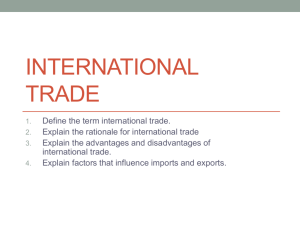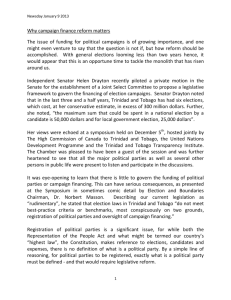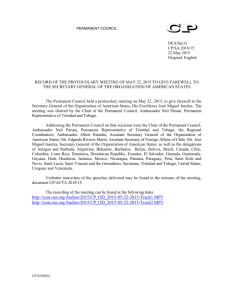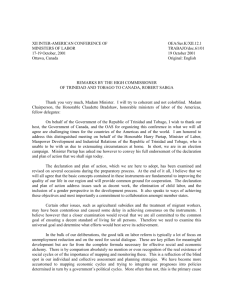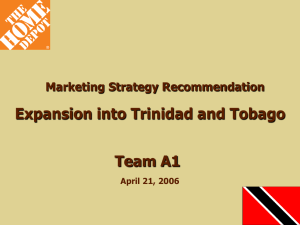W T O
advertisement
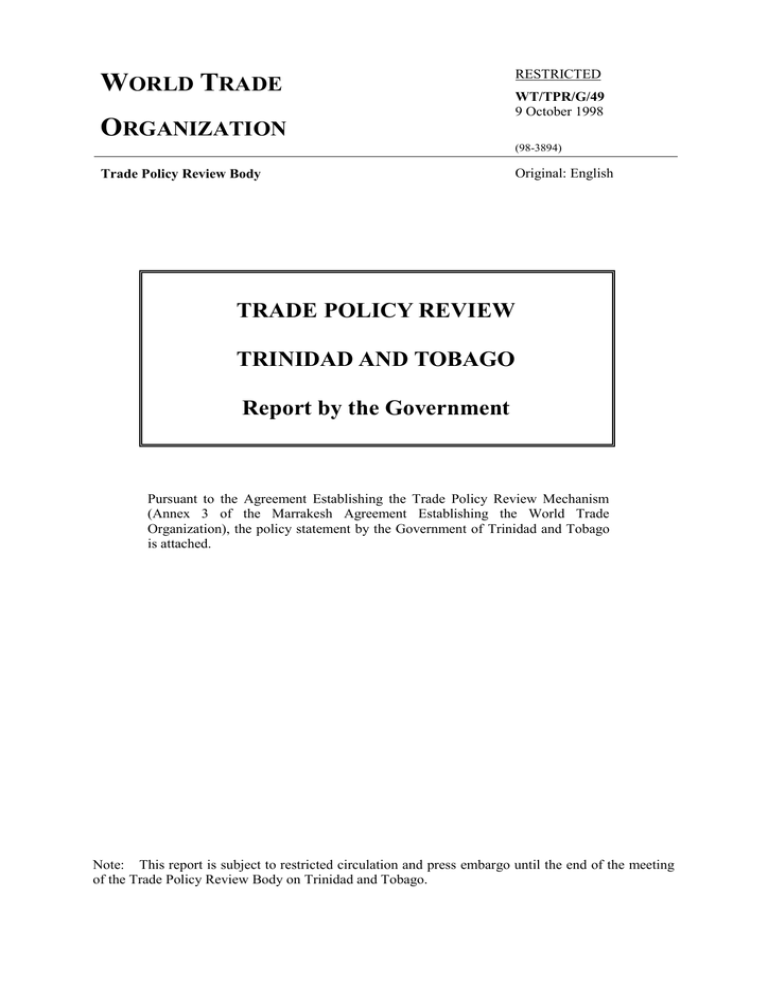
WORLD TRADE ORGANIZATION RESTRICTED WT/TPR/G/49 9 October 1998 (98-3894) Trade Policy Review Body Original: English TRADE POLICY REVIEW TRINIDAD AND TOBAGO Report by the Government Pursuant to the Agreement Establishing the Trade Policy Review Mechanism (Annex 3 of the Marrakesh Agreement Establishing the World Trade Organization), the policy statement by the Government of Trinidad and Tobago is attached. Note: This report is subject to restricted circulation and press embargo until the end of the meeting of the Trade Policy Review Body on Trinidad and Tobago. Trinidad and Tobago WT/TPR/G/49 Page 3 CONTENTS Page I. INTRODUCTION .................................................................................................................. 4 II. ECONOMIC POLICY AND ENVIRONMENT .................................................................... 4 III. TRADE AND INVESTMENT POLICY – A REVIEW ........................................................ 6 IV. CURRENT INDUSTRIAL POLICY ..................................................................................... 8 V. AGRICULTURAL POLICY .................................................................................................. 9 VI. EXTERNAL TRADE DEVELOPMENT – NEGOTIATIONS, ETC. ................................... 9 VII. CONCLUSION ..................................................................................................................... 14 WT/TPR/G/49 Page 4 I. Trade Policy Review INTRODUCTION 1. Trinidad and Tobago prior to the 1980's pursued an industrialization policy based on import substitution, which involved a strategy of utilizing relatively cheap labour combined with both local and foreign investment, implementation of a regime of fiscal incentives including tax holidays and duty concessions, and a system of quantitative restrictions in the form of a Negative List. Although this strategy produced some measure of growth in the productive capacity of the country, the meaningful diversification or transformation of the country’s production base was not realized. 2. Consequently, in the 1980's, with the accrual of substantial windfall earnings from the increase in the price of petroleum on the international market, the focus of industrialization policy shifted to economic diversification and transformation largely through investment in the energy-based sector. Policy initiatives were also taken to stimulate development of the non-oil manufacturing sector, with a focus on exports. 3. These initiatives to develop the non-oil manufacturing sector via a trade liberalization regime were intensified largely through a Structural Adjustment Programme (SAP) which was embarked upon by the Government of Trinidad and Tobago in 1990. Within the context of the SAP, the Trade Reform Programme has been specifically geared to foster improved efficiency in the operations of local companies, expansion in export-oriented production in the manufacturing, services, tourism and agricultural sectors, enhanced international competitiveness and increased export earnings, all of which would contribute to sustained growth, increased generation of employment and an overall improvement in the standard of living in Trinidad and Tobago. 4. The Trade Reform Programme essentially seeks to transform the trade regime from one which was inward-looking to one which is outward-looking, based on the principle of export-led growth and the development of an investment regime with an improved legal, regulatory and institutional framework, aimed at rendering the economy more attractive to export-led investment both local and foreign. 5. Within the policy reform environment, the private sector is expected to become the prime generator of economic growth and development. The role of the Government, on the other hand, has been redefined as a promoter and catalyst of trade and industrial development. 6. The Trade Reform Programme can be categorized into six major areas of activity, namely trade liberalization, enhanced competitiveness, sectoral programmes, market access opportunities, the Free Zones Programme and institutional support measures and facilities. 7. These trade policy measures have been supplemented by a substantive reform of the financial, fiscal and investment legislation, including the removal of foreign exchange controls and the flotation of the local currency. II. ECONOMIC POLICY AND ENVIRONMENT 8. The Government of Trinidad and Tobago has implemented a comprehensive economic programme since 1989, aimed at restructuring the economy and restoring a path of self sustaining, non inflationary growth. Monetary, fiscal, trade and investment policies have all been directed towards stabilising and diversifying the economy. 9. Fiscal policy has been conducted within the context of a comprehensive macro-economic structural adjustment programme. The Government of Trinidad and Tobago continues to maintain a prudent fiscal strategy. This strategy together with administrative restructuring of the revenue Trinidad and Tobago WT/TPR/G/49 Page 5 collecting agencies have resulted in an overall decrease in the fiscal deficit. The current account balance of the central government has recorded a surplus in the last five years contributing to improved national savings and a reduction in the investment/savings gap. 10. Monetary policy is being pursued with the priority objective of maintaining exchange rate stability, and the enhancement of the country’s foreign reserves. The foreign exchange rate was liberalized in 1993, since then Trinidad and Tobago adopted a floating exchange rate followed by the removal of exchange controls on the current and capital accounts. The Central Bank currently relies on the managing of liquidity and interest rate policy to achieve its main objective of a stable and low rate of inflation. The monetary authorities are increasingly adopting the use of open market operations as a tool for liquidity management, and reducing the dependence on the cash reserve requirement. It is expected that the use of open market operations will lower the cost of financial intermediation and therefore the cost of borrowing. 11. These initiatives have been accompanied by legislative and institutional reforms in the financial sector which were designed to facilitate the transformation of the domestic capital market. The following pieces of financial legislation have been revised and amended: (i) The Central Bank Amendment Act; (ii) The Financial Institutions Act; (iii) The Securities Industry Act; (iv) The Companies Act. 12. Consequently, the Securities and Exchange Commission was established in April, 1997 to supervise and regulate the authorities of the domestic stock exchange and to foster the use of this facility as a source of start-up capital for business ventures. 13. Government has also focused on the provision of capital for the development of the small business sector. The development of the small business sector is an essential prerequisite for the balanced development of the local economy. It is evident that this sector will continue to be the foundation for the Trinidad and Tobago economy by providing products and services and most importantly, opportunities which would permit the small investor to gain a foothold in the local market. 14. In keeping with these objectives, Government has improved the range of fiscal incentives which are available to the small business sector. These incentives were outlined in the 1998 budget presentation and include: (i) an increase in the loan guarantee ceiling available for small business financing; (ii) the asset value threshold for qualification as a small business at the Small Business Development Company (SBDC) has been increased from $500,000 to $1.5 million; (iii) Government’s annual financial grant to the SBDC has been increased to $8 million. 15. These initiatives have immediately borne fruit, based on figures supplied by the SBDC which indicate that loan applications have increased by 30% between January to March, 1998 when compared to the same period in 1997. In fact, a total of $5 million in loan guarantees have already been processed in 1998. WT/TPR/G/49 Page 6 Trade Policy Review 16. The recently introduced Venture Capital Act will also serve to enhance the sector’s ability to obtain much needed financial inflows. The Venture Capital Act is designed to promote the injection of equity capital into small and medium sized enterprises, without the burden of excessive financial charges which are usually associated with debt financing. 17. Based on the above factors, it is obvious that Government’s economic policies are specifically designed to foster private sector growth and development by providing a favourable climate for investment and commercial activities. The role of the Government has therefore been transformed to that of a promoter and catalyst of trade and industrial development. 18. The implementation of the programme of structural reforms has impacted favourably on the economy. In 1997, Trinidad and Tobago’s economy recorded its fourth consecutive year of economic growth. Real output has been positively growing by an average of 3% since 1994 (Table 1). This growth has been propelled by increased exploration and production activity in the Petroleum Sector as well as expansion in the output of the non-oil sector. In 1997, strong performances were recorded in the manufacturing, construction, distribution and transport sub-sectors, while the tourism sector displayed increased vibrancy. Such improved performance highlights the continued success of government’s policy towards diversification of the economy. 19. The growth in the economy has impacted positively on both the unemployment and inflation rates. The annual average rate of inflation has been on the decline, from 11.4% in 1993 to 3.7% in 1997. The reduced rate of inflation was partly due to the reduction or removal of import surcharges on several categories of capital and consumer goods. 20. The rate of unemployment has also reflected a significant contraction, from 22.4% of the labour force in 1989 to 15% in 1997. Overall the economy is reflecting a positive trend. Table 1 Macro-economic indicators of the economy of Trinidad and Tobago, 1989 – 1997 (MN$TT and per cent) 1989 1990 1991 1992 1993 1994 1995 1996 1997 15,894.90 16,134.4 16,567.3 16,294.4 16,057.5 16,630.3 17,265.2 17,872.6 18,450.8 Growth rate -0.8 1.5 2.7 -1.7 -1.5 3.6 3.8 3.5 3.2 Unemployment rate 22.4 20 18.5 19.6 19.8 18.4 17.2 16.3 15.0 Imports 5,188.0 5,370.4 7,084.8 6,101.1 7,495.3 7,811.7 11,363.3 12,989.1 18,705.9 Exports 6,695.4 8,850.9 8,436.4 7,943.0 8,800.9 11,575.4 14,512.1 15,028.9 15,887.6 Foreign reserves -434.3 187.5 3.4 -36.7 206.3 514.5 406.2 701.1 854.1 11.4 11 3.8 6.5 10.8 9.4 5.4 3.3 3.7 148.9 109.4 144.1 171.0 372.6 521.0 295.7 402.4 999.6 GDP 1985 Constant prices Rate of inflation Direct investment Source: Central Bank of Trinidad and Tobago & Central Statistical Office. III. TRADE AND INVESTMENT POLICY - A REVIEW 21. The Trade Policy of Trinidad and Tobago is outlined in the document entitled “Trade Policy for the Republic of Trinidad and Tobago 1997 - 2001". As mentioned before, since 1991, the Government of Trinidad and Tobago has undertaken a number of measures in order to diversify the economy and promote sustainable export led growth and development. These programmes were Trinidad and Tobago WT/TPR/G/49 Page 7 undertaken within the context of the global trend towards trade liberalization and the growing preponderance of mega trading blocs. 22. The basic elements of the Trade Reform Programme include: (i) The elimination of the Import Negative List; (ii) The reduction of the Common External Tariff on imported goods; (iii) The removal of price controls; (iv) The removal of stamp duty on imported goods; (v) The computerisation of Customs import and export procedures. 23. The Trade Reform Programme is closely linked to initiatives to attract foreign investment and to facilitate the development of the domestic industrial base. It is obvious that an essential prerequisite for the take-off of the economy is a substantial pool of capital, which would be utilised to fuel investment in the private sector. Such capital could be derived from both domestic and foreign sources. 24. It is acknowledged that foreign investors and to some extent local investors can invest their funds anywhere in the world especially through the electronic networks. In this context, it is imperative that Trinidad and Tobago develops an environment that is conducive to investment, in particular to devise an appropriate incentive framework. 25. Therefore, Trinidad and Tobago’s investment thrust is characterised as follows: (i) The creation of a more investor-friendly climate in the local economy. Therefore Government will seek to highlight the recent reforms which have been undertaken so that foreign investors will become aware of these efforts. To this end, the Foreign Investment Act will be amended to ensure that it is more promotional and less regulatory in nature. In this regard a draft bill, the Investment Promotion Bill, has been prepared by the Chief Parliamentary Counsel, and is at present being reviewed by an Inter-ministerial Committee following which it will be reviewed by the Legislative Review Committee before being tabled in Parliament. If approved, the Bill will become the Investment Promotion Act and replace the present Foreign Investment Act. (ii) The continued effort on the part of Government to reduce the number and complexity of the bureaucratic procedures involved in investment and business transactions. The objective is to make these procedures as simple and transparent as possible. (iii) Finally, Government will utilize the resources of its overseas missions and other related agencies to market the country as an attractive location for investment. 26. In keeping with these guidelines some of the major pieces of legislation which impinge on investment have been either revised or amended. These include the Fiscal Incentives Act and the Value Added Tax Act. 27. The Government of Trinidad and Tobago has also introduced an enhanced investment incentive framework. The basic incentives to investors are: WT/TPR/G/49 Page 8 - Trade Policy Review tax holiday or partial holiday under the Fiscal Incentives Act to approved industrial projects; exemption from corporation tax on profits, and dividends (under the Fiscal Incentives Act and Hotel Development Act); loss write-off provisions; training subsidies for developing new skills; provision of industrial sites and developed industrial accommodation; export allowances and promotional and developmental assistance; export credit insurance; double taxation relief; exemption from Value Added Tax on inputs for companies exporting 100% of production. 28. Government has also reduced the maximum level of corporation tax from 40% to 35% in a bid to reduce the cost of doing business. Free Zones Programme 29. Another key element in the quest to attract foreign investors is the Free Zones Programme. This Programme is intended to attract export-oriented firms which would not otherwise have located operations in Trinidad and Tobago. Some of the advantages which are derived from locating in a Free Zone include: - - total exemption from customs duties on capital goods, spare parts, raw materials, etc., for use in the construction and equipping of the premises and in connection with the approved activity; no import or export licensing requirements; no land and building taxes; no foreign currency or property ownership restrictions; exemption from corporation and withholding taxes in respect of profits or gains from approved free zone activities and business levy on sales; no VAT on goods supplied to a Free Zone. 30. The Free Zones Programme in Trinidad and Tobago has developed quite differently from other Caribbean Programmes and in the process, has created a vehicle for economic development with particular features including the fact that all infrastructure is currently provided by private investors and the jobs that are created are generally of a high quality. The Programme is gradually becoming self sufficient and is expected eventually to reduce substantially its dependency on the Treasury. The Free Zones approach will continue to be one of the main planks of the country’s export strategy. 31. These efforts will be complemented by a series of key strategies and measures among which would be the procurement of enhanced market access opportunities for locally produced goods and services, mainly through the process of negotiations, to the markets of targeted countries. IV. CURRENT INDUSTRIAL POLICY 32. Trinidad and Tobago’s Industrial Policy focuses mainly on the development of the non-oil manufacturing , non-financial services and small business sectors. The Policy is designed to create an expanded, diversified export oriented non-oil business sector. The Policy objectives are to: - generate sustained economic growth and balanced, integrated development; encourage increased investment flows into export-oriented production; Trinidad and Tobago - WT/TPR/G/49 Page 9 expand the range of business activity in the non-oil business sector; generate permanent employment opportunities; increase the export earnings of the non-oil business sector; ensure that economic development takes place in harmony with national environmental consideration; mitigate the consequences of business failures; assist in the attainment of the country’s food security objective. 33. In support of this programme several strategies and measures will be implemented in order to assist the business sector in its restructuring efforts, and therefore enabling the non-oil sector to become more export-oriented. These strategies and measures address the following areas: investment; human resource development; financing; business information; institutional and regulatory reform. V. AGRICULTURAL POLICY 34. In keeping with the objective of trade liberalisation in all sectors of the economy, Government has implemented a number of reform measures in the agricultural sector. These include: VI. (i) conversion of non-tariff import measures (negative list, government monopoly) to a tariff equivalent system, consistent with the GATT 1994 Agreement on Agriculture and to extend and strengthen trade and price liberalization in the agricultural sector; (ii) phased reduction of the dispersion among tariff rates and their average level in order to improve the incentives facing agriculture consistent with comparative advantage and attaining benefits for consumers from improved market access and lower food costs; (iii) within the framework of establishing tariff structures, maintenance of an open and transparent trade regime for agriculture with a minimum of government intervention; (iv) containment of direct support payments and subsidies to producers consistent with the GATT 1994 Agreement and prudent domestic fiscal management; and (v) restructuring and divestment of State-owned enterprises. Caroni (1975) Ltd. is a state-owned enterprise and the only producer of sugar in the country. A major goal of the GORTT is to make this company financially viable. Caroni (1975) Limited is to be reorganized to make its management and operations more efficient. The company is committed to implementing changes to reduce its costs through labour reduction, increased reliance on the supply of privately cultivated cane, improved cane production and greater factory efficiency. EXTERNAL TRADE DEVELOPMENT – NEGOTIATIONS, ETC. 35. One of the major objectives of the Trade Reform Programme which has been implemented by the Government of Trinidad and Tobago is the creation of an expanded, diversified export oriented production base in the non-oil sector of the economy. This initiative will be complemented by a series of key strategies and measures prime among which would be the procurement of enhanced market access opportunities for locally produced goods and services mainly through the process of negotiation to the markets of targeted countries. 36. Therefore, Trinidad and Tobago’s market access strategies will undoubtedly be influenced by the ongoing process of liberalization and globalization of the world economy. Such developments in the world economy have led to the configuration of the international economy into economic WT/TPR/G/49 Page 10 Trade Policy Review mega-blocs. These developments have made it imperative that countries like Trinidad and Tobago should learn the rules of the game in order to effectively exploit the numerous opportunities that are available to local exporters now that tariff and other traditional trade barriers have been significantly reduced. 37. The proliferation of these various trade blocs has forced Trinidad and Tobago to accelerate the pace of integration or face the prospect of being marginalized by the sheer volume of trade and investment flows which could be directed to these trade blocs, at the expense of local producers. 38. In this regard, it is significant to note that Trinidad and Tobago’s traditional markets are located within the EU and Western hemisphere, in addition to CARICOM. Non-traditional country markets are located in economic blocs such as MERCOSUR, the Andean Community, the Central American Common Market and the Association of South East Asian nations, among others. Against this background, it is imperative for Trinidad and Tobago to expand its export production in a bid to effectively compete on the international market. Therefore, Trinidad and Tobago has adopted a dual approach in order to maximize market access opportunities. Consequently, efforts would be directed towards expanding market share for non-traditional products in traditional markets, particularly where preferential market access arrangements are available, such as Lomé, the Caribbean Basin Initiative (CBI) and CARIBCAN albeit over the short to medium term while seeking to penetrate nontraditional markets in a sustained and aggressive manner. 39. It would therefore be important to note that although the Government of Trinidad and Tobago is actively seeking to ensure that the national trade policy objectives are achieved, the realities of the configuration of the global economy may dictate, in most instances, that the negotiation of terms and conditions of access to markets be undertaken on an inter-regional or bloc to bloc basis. This has in fact been the case even in the pre-Uruguay Round scenario with respect to the Lomé, CBI and Caribbean arrangements which were negotiated with the CARICOM group of countries and similarly with the current agreements between CARICOM, Venezuela, the Dominican Republic and Colombia and the ongoing Free Trade Area of the Americas negotiations. The necessity for inter-bloc negotiations in the current post-Uruguay Round environment may become more pronounced with the passage of time. Trinidad and Tobago Negotiations with Third Countries 40. Trinidad and Tobago’s relations with Third Countries is based on the recognition of its limited size and openness of its domestic and CARICOM Markets and the principle that the growth and expansion of the local productive base can only be realised by the penetration of foreign markets. 41. As was mentioned above, Trinidad and Tobago is a Member State of the CARICOM grouping. CARICOM’s focus is the conclusion of reciprocal free trade agreements with the Latin American countries and those of the extra CARICOM Caribbean. 42. Trinidad and Tobago’s policy objective to undertake negotiations with third countries has been guided by the following considerations: (i) the enhanced efficiency and productivity capabilities of local producers would enable them to seize export opportunities in Latin American markets; (ii) the physical proximity of Latin American markets and those in the extra-CARICOM Caribbean to Trinidad and Tobago; Trinidad and Tobago WT/TPR/G/49 Page 11 (iii) the proposed negotiated reciprocal market access arrangements will provide a wider range of export possibilities into the Latin American and extra-CARICOM Caribbean markets for local exporters; (iv) the size of some of the Latin American countries and the diverse economic segments could provide niche market possibilities for local products; (v) the possibility of co-production and joint venture arrangements with Latin American and extra-CARICOM Caribbean entrepreneurs utilizing Trinidad and Tobago as a production platform to access markets, particularly those provided under the CBI, Caribbean and Lomé preferential arrangements; (vi) the cost-effective sourcing of raw materials by local enterprises which would contribute to the competitiveness of local products in both the domestic and export markets; (vii) opportunities for exploring the potential for the development of export trade in services to Latin America and the extra-CARICOM Caribbean. 43. In addition, Trinidad and Tobago has joined its CARICOM partners in entering into reciprocal free trade agreements with Colombia and the Dominican Republic and will be seeking to enter into similar agreements with the Andean, Central American, and Mercosur regional groupings. This country will shortly initiate direct bilateral free trade negotiations with certain countries such as Mexico, Costa Rica and Panama. Trinidad and Tobago’s Role in the CARICOM Single Market 44. Trinidad and Tobago is actively involved in CARICOM’s efforts to create a Single Market, a project which has been accelerated as a direct consequence of international developments such as the proposed establishment of the Free Trade Area of the Americas and other globalization trends. 45. A single market will allow CARICOM to optimise its limited financial and economic resources in a bid to enhance its market leverage in the external trade negotiation process. NAFTA/CBI and CARIBCAN Agreements 46. Trinidad and Tobago is a beneficiary of the CBI and CARIBCAN preferential agreements. The CBI Agreement offers duty free access to exports of selected Caribbean and Central American countries into the market of the USA. CARIBCAN offers a similar facility for Caribbean exports into the Canadian market. A number of products are excluded from preferential treatment. Methanol and Lube Oil were included under the CARIBCAN in 1998. These products are of vital interest to Trinidad and Tobago. 47. It is important to note that with the creation of the North American Free Trade Agreement (NAFTA) the preferential access enjoyed by Mexico into the markets of Canada and the United States in respect of these products which have been excluded from the CBI and CARIBCAN could erode the overall benefits which Trinidad and Tobago and other beneficiaries presently enjoy under these agreements. 48. In addition, it is quite possible that foreign investors presently located in Trinidad and Tobago and engaged in the manufacture of the products excluded under the CBI and CARIBCAN might seek to locate in Mexico in order to enjoy the benefits of NAFTA market access. This element of investment diversion has already been evident by the re-location of some foreign operations from the CARIBCAN to Mexico. WT/TPR/G/49 Page 12 Trade Policy Review 49. The result of such trade and investment diversion could be a loss of employment, and to some degree of economic dislocation. In the context of its production capability, Trinidad and Tobago is not currently affected in any substantial manner as some other CBI and CARIBCAN beneficiary countries. 50. In order to alleviate the possible adverse effect of the relative advantage enjoyed by Mexico from its membership in NAFTA, Trinidad and Tobago has joined its CARICOM partners in seeking to obtain “NAFTA Parity” or enhancement of the CBI in particular to include those products which are presently excluded with the aim of levelling the playing field for CARICOM exporters vis-à-vis their Mexican counterparts. Free Trade Area of the Americas (FTAA) 51. Consistent with its trade policy, the Government of Trinidad and Tobago has actively participated in the FTAA process at the Ministerial, Vice Ministerial and Working Group levels during the preparatory phase. It is prepared to participate in the second negotiating phase in a more focused manner, as part of a co-ordinated CARICOM effort, in order to ensure that its interest and that of the regional grouping is served, particularly as smaller economies, in the negotiating process. This country’s negotiating effort will be reinforced by the fact that it has been nominated to hold the post of Vice Chairman of the FTAA negotiating group on Competition Policy. The Lomé IV Convention 52. Trinidad and Tobago has benefitted from the preferential duty free access granted to local products under the provisions of the Lomé Convention. Negotiations are currently underway between the EU and the ACP countries including Trinidad and Tobago with respect to a successor arrangement to the Lomé IV Agreement. 53. This country has attended the recent launch of negotiations for a successor agreement to the Lomé IV. At this meeting, Trinidad and Tobago participated with other ACP states in preparing a negotiation strategy which stressed the following elements: (i) ACP states should continue to negotiate the successor agreement as part of a unified bloc; (ii) the need to recognise that certain ACP states are smaller and more vulnerable and should be granted differential treatment; (iii) the extension of preferential access arrangements for the entry of ACP products into the European market; (iv) removal or reduction of restrictive or non-tariff barriers in the EU as they relate to Rules of Origin, technical restrictions to trade and phytosanitary measures. Trade Supportive Agreements 54. One of the major planks of Trinidad and Tobago’s trade policy initiative is the negotiation of Foreign Investment Protection Agreements, referred to as Bilateral Investment Treaties, which have been concluded with several countries in an effort to maximize the benefits which could be derived from its trade and investment links with extra-regional trading partners. Trinidad and Tobago has concluded Bilateral Investment Treaties with Canada, the United Kingdom, France and the United States of America. Agreements with Germany, Venezuela, and Argentina, are currently being negotiated. Trinidad and Tobago WT/TPR/G/49 Page 13 55. An Intellectual Property Rights Agreement has been concluded with the United States and consideration is being given to entering into similar agreements with other countries. These agreements will provide a measure of security to potential investors and technology providers, and thereby improve the attractiveness of Trinidad and Tobago as a location for investment. 56. Trinidad and Tobago have entered into Double Taxation treaties with Canada, Denmark, France, Italy, Norway, Sweden, Switzerland, the United Kingdom, the United States, Venezuela and the Federal Republic of Germany. Future Policy Directions 57. Although the Trade Reform Programme and other trade related policy reform measures are already at an advanced stage of implementation, in seeking to determine the way forward, the Government of Trinidad and Tobago will continue to monitor developments in the international trading system and seek to create economic space for our domestic manufacturers/exporters. 58. In cognisance of the fact that the conduct of successful External Negotiations requires considerable human, institutional and financial resources, the Government of Trinidad and Tobago has established a National External Trade Negotiating Mechanism, the main element of which is a Technical Coordinating Committee comprised of public/private sector officials which conduct preparatory consultations with a view to making recommendations to the Government on the positions and strategies to be adopted by the national negotiating teams in various fora. A number of possible plans have already been identified for the continued enforcement of this country’s external trade policy. These include: (i) The continued negotiation of an extension of existing preferential trade agreements, such as the CBI and CARIBCAN; (ii) continued negotiation of NAFTA parity for countries of the CBI; (iii) determination of the priority to be afforded to relations with Europe in light of the fact that the new successor arrangement to Lomé IV will be based on reciprocity; (iv) pursuing integration efforts within the Wider Caribbean in an effort to use their bargaining leverage in external negotiations, particularly in the FTAA; (v) the development of strategies to maximise the benefits of small market size while developing a competitive edge on the international market. Export Promotional Programme and Initiatives 59. In this regard, the Government proposes to organize and co-ordinate a number of promotional exercises. 60. These initiatives will be facilitated by: (i) the organisation of visits by Trinidad and Tobago producers and entrepreneurs to specific markets abroad; (ii) the mounting of exhibitions by Trinidad and Tobago producers in the target markets; (iii) the participation by Trinidad and Tobago producers in specific or general fairs and exhibitions in foreign countries; WT/TPR/G/49 Page 14 (iv) Trade Policy Review the posting of commercial officers in Trinidad and Tobago’s Government Missions abroad; Far Eastern Countries 61. Trinidad and Tobago has for many years been a net importer from many countries in the Far East including India, Japan, Singapore, Hong Kong, China and Korea. These countries are members of the proposed Asia Pacific Economic Cooperation trading bloc. In view of this fact, the Government has identified the Far Eastern countries as potential niche markets for non-traditional products and for the expansion of market share with respect to its current exports. More particularly, these countries have been targeted as potential sources of investment into the Trinidad and Tobago economy. Other Countries 62. The Republic of South Africa is prime among the countries in Africa and the Middle East which in the future may be targeted in the implementation of Trinidad and Tobago’s trade policy. In addition to the possible export opportunities, joint venture investments in these markets by Trinidad and Tobago’s entrepreneurs might be a feasible approach to gaining market share in those countries. VII. CONCLUSION 63. The Government of Trinidad and Tobago has formulated a plan of action which is designed to facilitate the meaningful integration of the local economy into the globalized trading environment. This plan of action which is expressed in the domestic trade and industrial policies will be supported by an aggressive negotiation process which will target specific countries and the multilateral forum such as the WTO and FTAA. 64. The basic objectives will be the generation of enhanced investment, employment and trade flows between Trinidad and Tobago and its trading partners. Trinidad and Tobago is determined to become an active player in the globalized trading environment. __________



